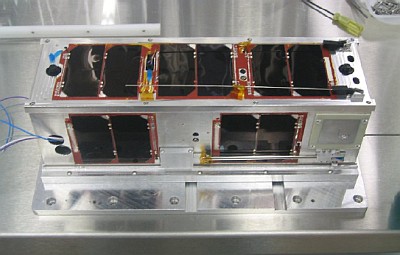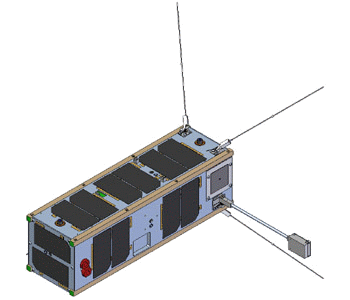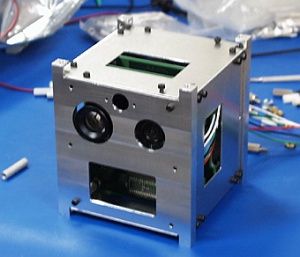CanX-2
Am 28.04.2008 startete pünktlich und reibungslos um 0353UTC eine PSLV-C9 Rakete ins All. Es war eine internationale Mission, 10 Satelliten mit einem Gesamtgewicht von 816 kg wurden vom indischen Satish Dhawan Space Centre in Sriharikota aus in ihren Orbit gebracht. Hauptnutzlast war CartoSat-2A (690kg) und ein Microsat TWSat (Third World, 76kg), beide dienen den Fernerkundung der Erde. Zudem weitere 8 Nanostaelliten mit einem Gesamtgeweicht von etwa 50kg. Das Cluster NLS-4 bestand aus CanX-2, AAUSat-II, COMPASS, DELFI-C3, SEEDS und CUTE1.7+APD II. Der siebte Satellit (NLS-5/CanX-6) kam aus Canada und zuletzt RUBIN-8 aus Deutschland, der allerdings auf der Trägerstruktur verblieb.

NASA-Catalog: ?
Downlink
2407.650 FSK AX.25
Die UHF Bake wurde entfernt. CanX-2 wird also nur auf Befehl und im Bereich der Kommandostation in Toronto senden (im S-Band).
Call
VA3SFL
Status
CanX-2 never had a 70cm beacon. An earlier design for the satellite include a 2m CW beacon, but this was descoped from the final design. Its 70cm transmitter has not been turned on yet, and the satellite does not send any uncommanded beacon packets.
CanX-2 satellite is presently operating well though its S-Band downlink, which we have coordinated a frequency in the Space Research Service Band around 2.2GHz. Due to power limitations only one downlink will be active during a pass over our ground station in Toronto, Canada.
73, Daniel, VA3KKZ
| Flight Sequence ====================================== T=0.0s PS1 Ignition T=113.14s PS1 Separation (h=50.42km) T=113.34s PS2 Ignition (h=50.60km) T=188.14s Heat shield separation T=264.04s PS2 Separation (h=204.18km) T=265.14s PS3 Ignition (h=205.56km) T=524.24s PS3 Separation (h=507.48km) T=540.0s PS4 Ignition (h=518.42km) T=844.2s PS4 Cut off (h=637.66km) + 37.0s Cartosat-2A separation + 47.0s Reorientation of PS4 starts + 67.0s Reorientation of PS4 ends + 82.0s TWSAT separation +122.0s Reorientation of PS4 starts +142.0s Reorientation of PS4 ends +200.0s CanX-2 separation +220.0s Cute 1.7+APD II separation +240.0s Delfi-C3 separation +260.0s AAUSat-II separation +280.0s COMPASS-1 separation +300.0s SEEDS separation 0353 UTC — Launch of PSLV-C9 (-0/+10 min) 0430 UTC — Injection elements from LV INS 0500 UTC — First NORAD sensor track 0600 UTC — NORAD element set published |   |

Homepage und weitere Info’s
http://www.utias-sfl.net/nanosatellites/CanX2/
CanX-1

Am 30. Juni 2003, 1415 UTC startete eine zweistufige Rockot-Rakete vom Plesetsk-Raumfahrtzentrum mit neun Satelliten. Neben einem russischen, einem tschechischen und einem kanadischen MicroSat, waren 6 weitere Satelliten einer neuen und preiswerten Bauart, sogenannte CubeSat’s an Bord. Die “Würfel-Satelliten” haben eine Kantenlänge von 10 cm und werden als NanoSat’s klassifiziert. Alle CubeSat’s tragen auch eine Amateurfunk-Nutzlast (Bake).
“Canadian Advanced Nanospace eXperiment 1 (CanX-1)” ist Kanada’s erster Nanosatellit. Er wurde von Studenten des Space Flight Laboratory (SFL) an der University Toronto, Institut for Aerospace Studies (UTIAS), gebaut. Er ist einer der kleinsten Satelliten, die gebaut wurden. Er hat ein Gewicht unter 1kg und passt in einen 10cm Würfel. Seine Leistung beträgt etwa 2 Watt. Die Mission dient zu Bewertung neuer Technologien im Weltall, z.B. einen low-cost CMOS Horizon sensor, einen Sternen-Tracker, aktive 3-Achsen magnetische Stabilisierung, GPS-basierende Positionserkennung und einen ARM7 Zentralcomputer.
NASA-Catalog: 27847
Downlink
437.88 MHz AFSK 1200Hz/1800Hz
Call
CanX-1
Status
nicht aktiv
Homepage und weitere Info’s
http://www.utias-sfl.net/
Empfangsberichte bitte an: dkekez@utias-sfl.net